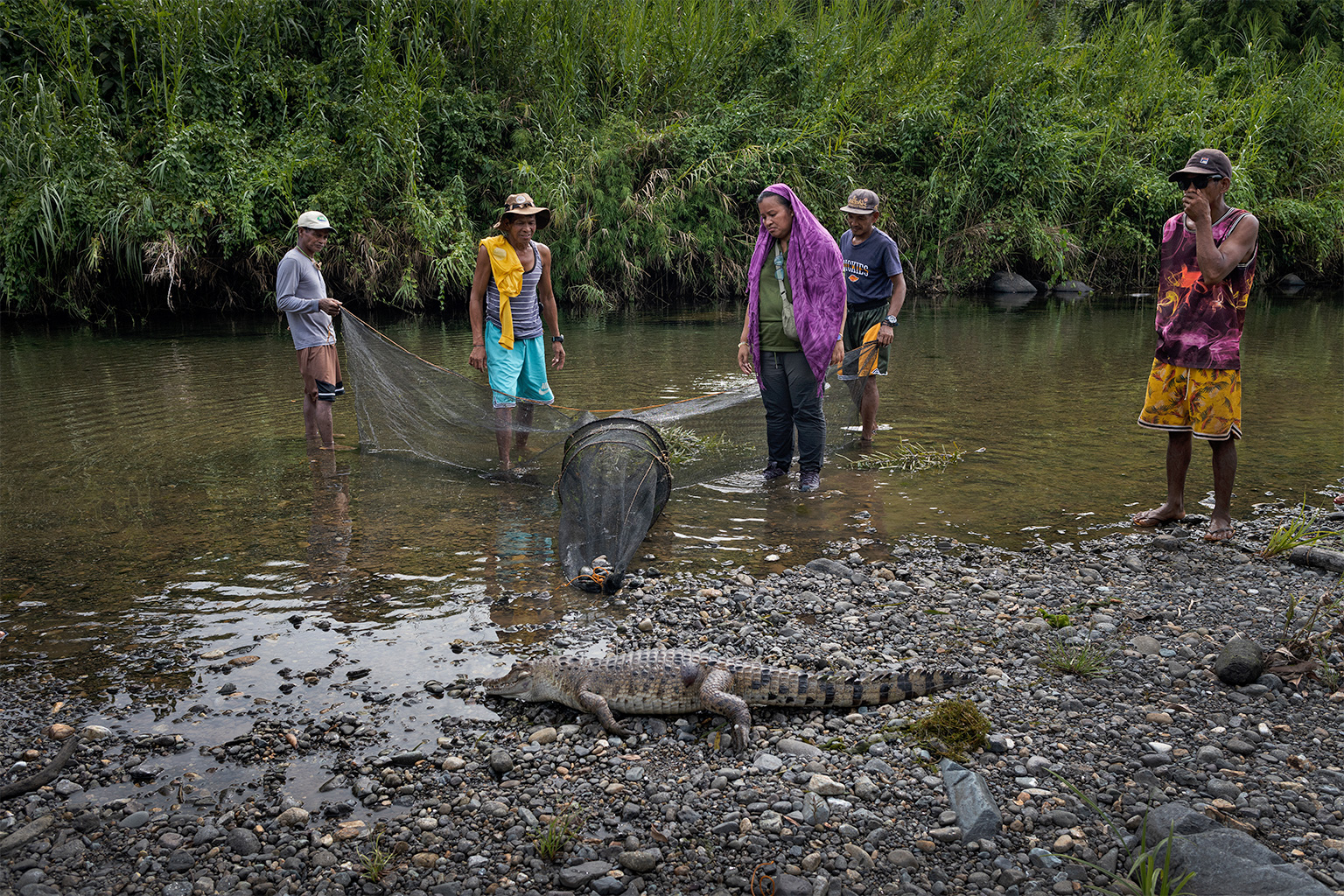- The critically endangered Philippine crocodile (Crocodylus mindorensis) embodies strength and protective spirits for Indigenous Agta elders who are involved in efforts to rebrand the image of the predator.
- Thanks to conservation efforts led by the Mabuwaya Foundation in partnership with local and Indigenous communities, the wild crocodile population in a region of the northern Philippines increased from one adult in 1999 to 125 individuals by 2024.
- Community sanctuary guards, known as Bantay Sanktuwaryo, play a significant role in safeguarding the crocodiles and their habitat despite ongoing challenges posed by illegal fishing, agricultural encroachment and inadequate law enforcement.
- Conservationists warn that without stable funding and stronger government support, even successful grassroots efforts may not ensure the species’ long-term survival.
DUNOY, Philippines — In the dense, tropical rainforests of the Northern Sierra Madre Natural Park, an ancient predator drifts silently beneath the surface of still rivers. For Indigenous Agta elders, this reptile is not a menace, but a guardian.
“We have always coexisted peacefully with crocodiles, and today I am passing on to my grandchildren the same advice my parents gave me,” says Olalia Infiel, an Agta elder of Dunoy. “I often encountered crocodiles while washing clothes or bathing in the river. My parents always told me to speak to the crocodiles first and ask for their permission to share the same space.”
The Philippine crocodile (Crocodylus mindorensis), a severely threatened crocodile species, is staging a slow but hopeful comeback in the wild, thanks to an alliance between science, tradition and community-led conservation.
Once widespread across the Philippine archipelago, the species is listed as critically endangered by the International Union for the Conservation of Nature (IUCN). Fewer than 250 individuals survive in the wild today, local conservationists say, and most are confined to these rivers and wetlands of northeast Luzon.
According to local conservationists, the Philippine crocodile’s survival in recent decades is highlighting how Indigenous knowledge, when integrated with conservation science, can support efforts to protect even the most endangered species.


A guardian reimagined as a pest
The perception of crocodiles in the Philippines has changed dramatically over the centuries.
Before Spanish colonization in 1565, crocodiles were not feared monsters among the Agta, one of the oldest forest-dwelling groups in the north of the archipelago. Among the first inhabitants of the Philippines before Austronesian migrations, the Agta saw crocodiles as spirits. They were associated with strength, fertility and power — figures to be respected rather than hunted.
According to Agta traditional stories before the advent of Christianity, crocodiles are the embodiment of protective spirits, called anito, believed to inhabit a parallel underwater world. Encounters with crocodiles were understood as spiritual exchanges, governed by customs and beliefs passed down through generations.
“My grandfather used to say, ‘Leave the crocodile in peace and he will do the same.’ For us, the crocodile is like a guardian who helps us to protect our rivers,” says Nestor Aliejo, leader of the Agta communities of Dunoy and Villa Miranda. Many Agta communities living in less remote areas have converted to Christianity over time and fewer younger generations hold onto the ancient beliefs today. Nevertheless, a culture of respect for crocodiles endures.
This relationship, built on a long-cultivated awareness of each other’s presence, is one of shared space and acknowledged boundaries, Aliejo says. For centuries, the Agta have shared riverbanks, fish and forests with the Philippine crocodile. According to local conservationists, this mutual respect makes the areas where these Indigenous communities live some of the only places where the Philippine crocodile survives in the wild today.

For centuries, the forest ecosystem has been maintained intact, thanks to the knowledge of the Indigenous people who lived in harmony with the animals and only took from the Earth what was needed to sustain themselves. However, the colonial and postcolonial periods changed both the landscape and the way people interacted with the environment. This posed a serious threat to the survival of endemic species, such as the Philippine crocodile, which was decimated.
This was due to unsustainable hunting by the Spanish and the arrival of farmers from other areas of Luzon in the 1960s and ’70s, creating rapid population growth and land scarcity in the lowlands.
At that time, the Philippines was also among world’s leading exporters of tropical hardwoods. Logging companies opened up the forests and wetlands of the northern Sierra Madre to exploit their natural resources. Farmers converted secondary forests and swamps into agricultural fields.
Due to commercial interests, crocodiles were no longer revered. Instead, they were demonized. First the Spaniards, and then the farmer settlers who moved into the area in search of more cultivable land, considered the crocodiles pests and obstacles to progress, hunting and poisoning them in order to force the animals out of their habitats. The crocodile’s reputation shifted from guardian to villain, and its Tagalog name, buwaya, became synonymous with greed and corruption.
Indigenous practices were no longer sufficient to ensure the survival of this species in the wild. Despite the shift in narrative and environmental landscape, Agta people we speak with say they have never abandoned their belief in respecting the species. Older generations in particular continue to emphasize the importance of restoring the environment and living in harmony with the natural world. This reverence is passed to younger generations.
“By educating people about the importance of animals in the ecosystem, we can begin to protect them and restore the ecosystem’s natural equilibrium. This will undoubtedly improve the environment health and therefore our livelihood,” says Marshall Magas, an Agta man in his 50s from Gab-Gab village.

A turning point
According to early survey reports, the Philippine crocodile was presumed functionally extinct in the wild by the 1990s, with no verified sightings in decades, says Merlijn van Weerd, an ecologist at Leiden University. Consequently, researchers had not studied the species in its natural habitat. This changed in 1999, however, when a group of Filipino and Dutch researchers began intensive surveys in the Cagayan Valley. What they found was a handful of surviving adults and an estimated 20 individuals. This changed the course of the species’ fate.
The discovery led to the founding of the Mabuwaya Foundation in 2003. Its mission: to conserve the Philippine crocodile in its natural habitat through a combination of scientific research, habitat protection and community engagement.
“Protecting a species with such a negative image requires more than good science,” says van Weerd, also one of the founders of Mabuwaya. “You need trust and constant help in the field. For that, you need to actively involve the people who share the same habitat with the species.”
Mabuwaya’s work is focused on bridging these two worlds. Guided by the knowledge of Agta, Ilocano and Kalinga peoples, the foundation lobbied for the creation of eight crocodile sanctuaries across San Mariano. These sanctuaries protect crocodile habitats and regulate fishing. The sites are monitored by Bantay Sanktuwaryo, community members trained as sanctuary guards who patrol the rivers, report violations and protect the crocodile’s habitat.
“If I observe a threat to the crocodile, it is my responsibility to report it,” says Victorino Montanes, the first local person to be appointed as Bantay Sanktuwaryo in 2004. “Since I started this job, I have reported crocodile killings. However, most of the time, it is very difficult to find the culprit.”

While the crocodile is now protected under the Wildlife Act of 2001 (Republic Act No. 9147), enforcement is weak in these remote areas. The guards act as the first, and often only, line of defense. Their presence has enabled initiatives like the “Head Start Program,” in which wild hatchlings are collected and raised in semi-captive conditions at the Philippine Crocodile Conservation Center (PCCC) until they are strong enough to be released back into the wild.
The survival rate of crocodiles raised in this program, around 79%, is dramatically higher than in the wild, which can be as low as 5%, says van Weerd.
Leticia Afuang, a herpetologist and longtime advocate for biodiversity education in the Philippines, says she believes the survival of the Philippine crocodile depends on building meaningful relationships with the people who share its habitat.
“You have to turn local communities into allies,” she says. “They should be more than just aware of conservation; they should be proud to sustain it themselves.”
Mabuwaya’s integration of traditional ecological knowledge with data-driven conservation has yielded real results. From a few adult crocodiles observed in 1999, the population in San Mariano grew to 125 individuals by 2024 — including 17 adults, 41 juveniles and dozens of hatchlings, van Weerd says.
But success, here, is relative. The species is still teetering on the brink, researchers say.

Persistent threats
Deforestation, agricultural encroachment and weak law enforcement continue to threaten the crocodile’s fragile foothold in the wild. Farmers sometimes disregard buffer zone regulations and clear riparian vegetation to plant yellow corn. As the fish population has declined, people have begun using electrofishing and fine mesh nets in the surrounding rivers and creeks.
“It’s important to get people to respect the rules, but it’s difficult in this remote area,” says Nestor Gumarang, who has been a Bantay Sanktuwaryo since 2016 in Diwagden.
“People here think they can do whatever they want and get away with it. That is why it is important to help the authorities enforce the rules. It would be better if the authorities were more present, set a better example and increased the penalties for those who harm or kill crocodiles — even imprisonment.”
From talking to the locals who inhabit the small villages around the Ilagan River, there are still people who perceive crocodiles as a threat and view them with hostility, especially by farmers who are afraid their livestock will be attacked and kill them in retaliation. But there are fewer reports of this happening, the sanctuary guardians say, and they now receive calls to instead bring the crocodiles to the PCCC.

“We’ve come far,” says Rogelio Etchore, another Bantay Sanktuwaryo from Villa Miranda. “But there are still those who think the crocodile is dangerous or useless. That’s why we keep talking, visiting schools and reminding everyone that this is about more than just one animal. It’s about our river, our forest and our future.”
Afuang cites the Mabuwaya Foundation as an example of a conservation initiative that successfully involves local and Indigenous communities in key decision-making processes and daily monitoring efforts. However, she is also worried that their work could be lost in the future if they do not find other people who can secure international funding for the operations.
“Conservation is a multifaceted effort,” says Afuang. “You need science, management and community collaboration. But without funding and real government support, even the best initiatives struggle to survive.”
Meanwhile, at the back of the Isabela State University campus in San Mariano, conservationists are experimenting with captive breeding at the PCCC. Two adult crocodiles rescued in the early 2000s, a male taken from a conflict zone and a female with a deformed jaw, have not successfully bred, despite several attempts. A recent clutch of eggs turned out to be infertile, but for the first time, there is hope that captive reproduction could support population recovery in the future.


Unlike flagship mammals like pandas or tigers, crocodiles lack public sympathy. Their conservation requires patience, deep community ties and a willingness to work across cultural and ecological knowledge systems, says Marites Gatan-Balbas, director of operations at the Mabuwaya Foundation.
The Agta and other Indigenous peoples in the region continue to emphasize the need to respect crocodiles and the rivers they inhabit, viewing them as neighbors rather than threats. Conservationists working in the region echo this message, noting that long-term protection efforts will depend not only on policy and science but also on reviving cultural relationships with nature that recognize interdependence rather than dominance.
Banner image: The local community of Dunoy is releasing a juvenile specimen in a small creek adjacent to the Disulap River. The release of juvenile crocodiles into the wild represents the culminating phase of the “head-start program,” which seeks to enhance hatchling survival rates and facilitate the recovery of the Philippine crocodile population. Image by Giacomo d’Orlando for Mongabay.
Philippines’ largest freshwater wetland and Indigenous livelihoods face multiple threats
Latest Mongabay podcast episode: To save humanity and nature we must tackle wealth inequality, says Cambridge researcher. Listen here:
Citations:
Van der Ploeg, J. (2013). Swallowed by a cayman: Integrating Cultural Values in Philippine Crocodile Conservation. Cultural Anthropology and Development Sociology, Faculty of Social Sciences, Leiden University. Retrieved from: https://scholarlypublications.universiteitleiden.nl/handle/1887/20940
Van der Ploeg, J., van Weerd, M., & Persoon, G. A. (2011). A cultural history of crocodiles in the Philippines: towards a new peace pact? Environment and History, 17(2), 229–264. doi:10.3197/096734011×12997574043008
Tarun, B., Guerrero, J., Rodriguez, D., Telan, S.P., van Weerd, M., & van der Ploeg, J. (2004). The current distribution and population size of the Philippine crocodile and Estuarine crocodile in Northeast Luzon, the Philippines. In Proceedings of the 17th working meeting of the Crocodile Specialist Group, (166-173). Retrieved from: https://www.researchgate.net/publication/276205549_The_current_distribution_and_population_size_of_the_Philippine_crocodile_and_Estuarine_crocodile_in_Northeast_Luzon_the_Philippines
Feedback:Use this form to send a message to the author of this post. If you want to post a public comment, you can do that at the bottom of the page.
